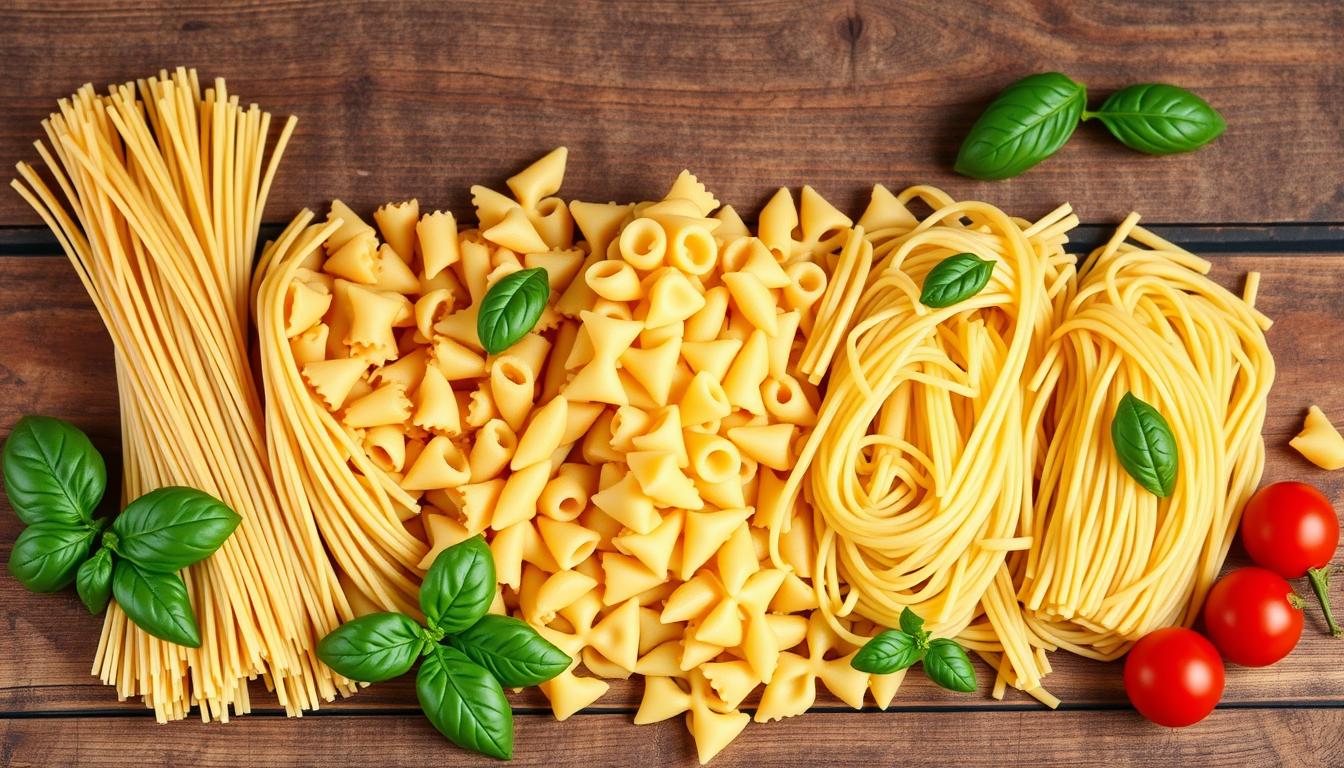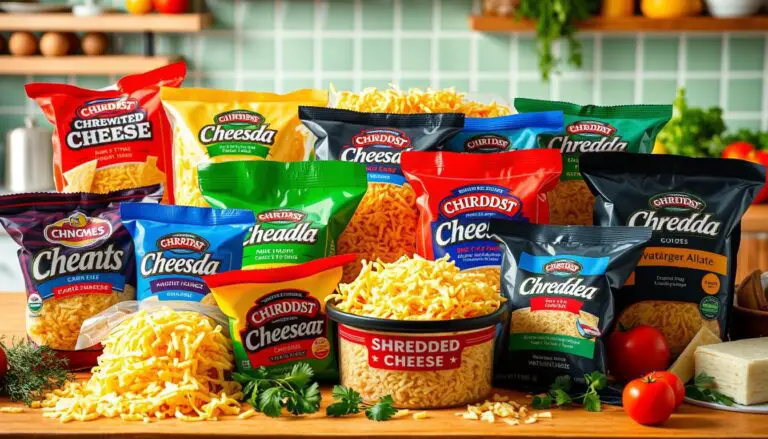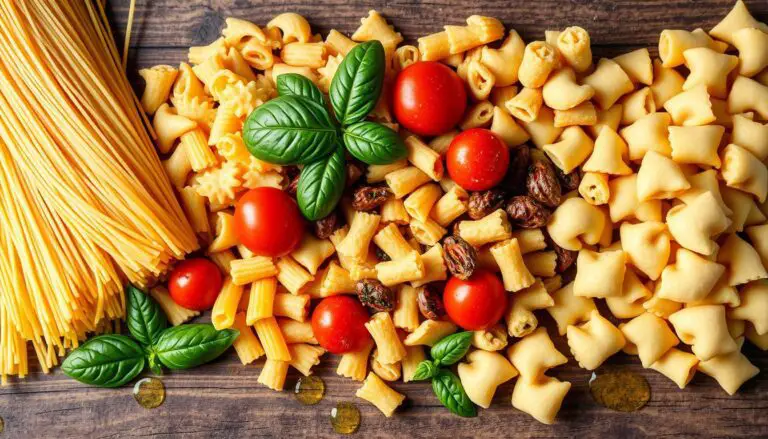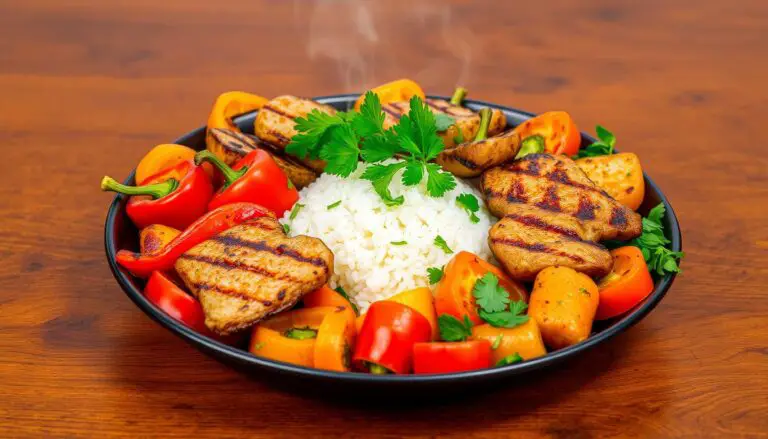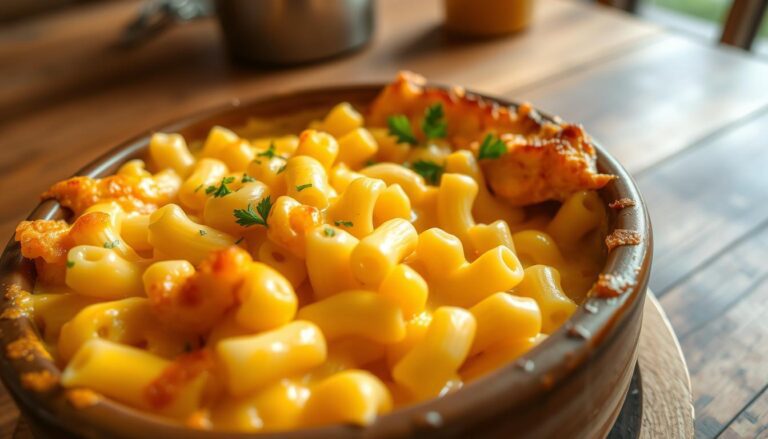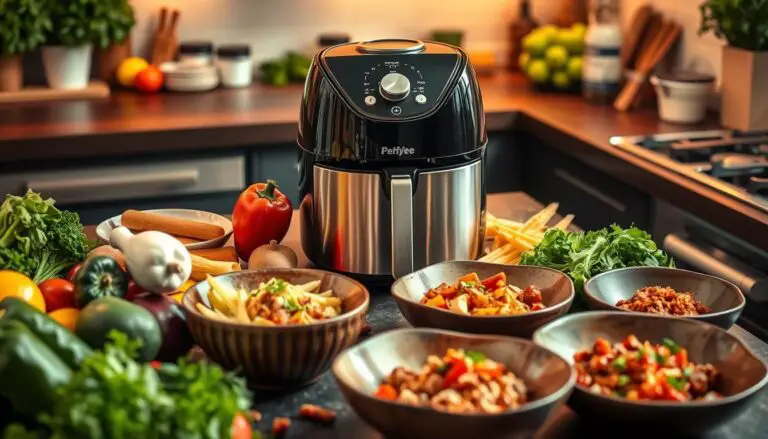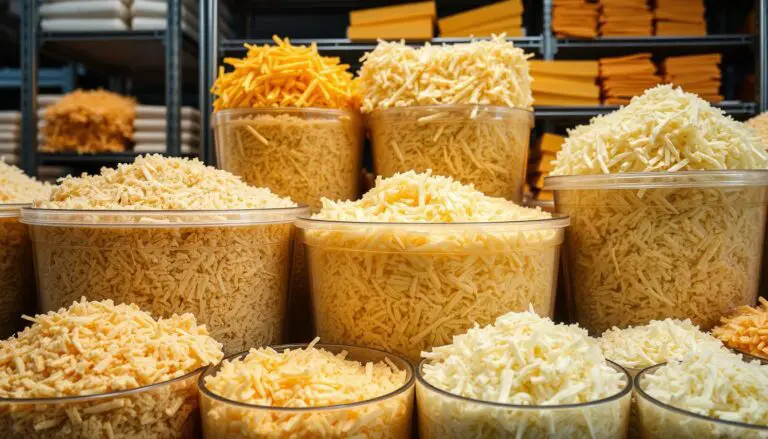5 Main Types of Pasta Explained | Essential Guide
Pasta is loved all over the world for its taste and flexibility. In this guide, we’ll look at the 5 main types of pasta. You’ll learn about everything from long noodles like spaghetti to stuffed pasta like ravioli. Knowing these types can make you a better cook.
As we explore pasta, you’ll see how each type can be used in many dishes. This makes pasta a big part of cooking traditions everywhere.
Key Takeaways
- Discover the 5 main types of pasta and their unique characteristics.
- Learn how different pasta varieties are used in various dishes.
- Understand the significance of pasta in culinary traditions around the world.
- Recognize the role of long, short, and stuffed pasta in enhancing meals.
- Explore how the types of pasta noodles vary in texture and flavor.
Understanding Pasta: A Brief Overview
Pasta is a key part of Italian food, with a history that goes back centuries. It comes in many shapes and sizes, each with its own story. Italian chefs have made pasta-making an art, using local ingredients and flavors.
Pasta can be sorted by shape, size, or how it’s made. You’ll find everything from long spaghetti to fancy tortellini. Each type is used in different ways, with various sauces adding to the fun.
The basic ingredients of pasta are wheat flour and water. Over time, recipes have changed, adding new tastes and textures. Eggs and other ingredients have also been added, making pasta even more diverse.
To learn more about pasta shapes and their uses, check out this guide. The history, regional flavors, and new twists in pasta keep food lovers interested. It’s a journey of discovery, inviting everyone to try different pasta varieties.
The Importance of Pasta in Culinary Traditions
Pasta is a key part of many global culinary traditions. It’s a staple in diets, showing the versatility of ingredients and cultural nuances. From Southern Italian rustic shapes to fine dining dishes, pasta goes beyond borders.
This ingredient is central to family gatherings and celebrations. It symbolizes togetherness and hospitality. The culinary history of pasta is rich, with families sharing recipes for generations. Pasta festivals celebrate local dishes, bringing communities together.
Pasta fits into local ingredients and cooking styles, thriving in different places. Countries have their own pasta dishes, shaped by local flavors and resources. This shows how pasta brings cultures together through food.
| Country | Signature Pasta Dish | Traditional Ingredients |
|---|---|---|
| Italy | Spaghetti Carbonara | Pasta, eggs, Pecorino Romano cheese, guanciale |
| China | Chao Mian (Fried Noodles) | Noodles, vegetables, soy sauce, meat |
| Japan | Yaki Udon | Udon noodles, soy sauce, vegetables, protein |
| Mexico | Sopa de Fideo | Fideo pasta, tomatoes, onions, spices |
Pasta’s importance in culinary traditions is its ability to adapt and connect people. Celebrating pasta cuisine honors its history and cultural bonds.
What are the 5 main types of pasta?
Pasta is a favorite in many cuisines, loved for its versatility and rich history. This section explores the main types of pasta noodles. It highlights their unique features and the dishes they pair well with.
Long Pasta Varieties
Long pasta noodles are perfect for many sauces and dishes. Some popular ones are:
- Spaghetti: Known for its thin, long shape.
- Fettuccine: Wide and flat, great with creamy sauces.
- Linguine: Similar to spaghetti but slightly wider, ideal for sauces.
These noodles are great for both simple and complex recipes. They work well with marinara and Alfredo sauces.
Short Pasta Forms
Short pasta forms are perfect for hearty dishes and casseroles. Some examples are:
- Penne: Tubular pasta with angled edges, perfect for holding sauces.
- Fusilli: Spiral-shaped, great for trapping sauce.
- Macaroni: Small elbow-shaped pasta, often used in baked dishes.
Short pasta forms are loved in both traditional and modern meals. They offer a chance for unique flavor combinations.
Stuffed Pasta Options
Stuffed pasta options are a delightful treat, filled with different ingredients. Some notable ones are:
- Ravioli: Square or circular pillows filled with cheese, meat, or vegetables.
- Tortellini: Ring-shaped pasta, often filled with cheese or meat.
These types of pasta noodles add a gourmet touch to meals. They allow for creative fillings and pairings, making dining more enjoyable.
Popular Pasta Shapes and Their Uses
Pasta comes in many shapes, each with its own special qualities. Knowing about these shapes helps cooks choose the right sauce and ingredients. Here, we look at common pasta shapes, their uses, and their cultural importance.
Common Pasta Shapes and Their Dishes
Different pasta shapes have different roles in cooking. Here are some examples:
- Farfalle: Its butterfly shape makes it great with creamy sauces or in pasta salads.
- Orecchiette: This small, ear-shaped pasta is perfect with thick sauces, especially those with greens and sausage.
- Lasagna Sheets: These flat sheets are key for lasagna, layering well with meat, cheese, and sauce.
Cultural Significance of Pasta Shapes
Pasta shapes often tell stories of regional traditions. Knowing their origins deepens our appreciation for pasta making:
- Farfalle: From Northern Italy, it shows the Italian focus on beauty and taste.
- Orecchiette: From Puglia, it highlights local ingredients and the impact of agriculture on pasta.
- Lasagna: A symbol of Italian celebrations, it represents abundance and hospitality in family events.
Pasta Classifications: Beyond Shapes
Pasta goes beyond just shapes. It can be sorted by texture, size, and how it’s cooked. Different pasta types, like smooth and ridged, affect how sauces stick to them. Smooth pasta is great with light sauces, while ridged pasta holds onto thick sauces better.
Knowing these categories helps pick the right pasta for dishes. Short pasta shapes, like penne, are best with chunky sauces. Long pasta, such as spaghetti, is better for oil-based sauces. This choice affects the dish’s look and taste.
Regional tastes also shape pasta types. In Italy, the north likes smooth pasta with less water and more eggs. This makes the pasta denser. The south, including Sicily and Calabria, prefers coarser pasta made with durum wheat, leading to a variety of sizes and shapes.
The ingredients used in pasta also matter a lot. Different flours can change the pasta’s taste and texture. Chefs and home cooks can play with these differences to make their pasta dishes better.
Differentiating Between Dried and Fresh Pasta
Pasta comes in two main types: fresh and dried. Chefs and home cooks need to know the differences to choose the right pasta for their dishes. This section explains how to make both fresh and dried pasta, including ingredients, texture, and cooking times.
Process of Making Fresh Pasta
Fresh pasta is made with simple ingredients like flour and eggs. It has a soft and tender texture. Here’s how it’s made:
- Mix flour and eggs to form a dough.
- Knead the dough until it’s smooth and elastic.
- Roll out the dough to the right thickness.
- Cut it into the desired shapes.
Fresh pasta cooks fast, usually in 2-4 minutes. It has a unique taste and texture, perfect for dishes like fettuccine or ravioli.
Understanding Dried Pasta Production
Dried pasta is made with semolina flour and water. It has a firmer texture that lasts longer when cooked. Here’s how it’s produced:
- Mix semolina flour and water to make a dough.
- Push the dough through dies to shape it.
- Dry the pasta slowly, which takes hours or days.
Dried pasta lasts longer and is great for many dishes. It takes 8-12 minutes to cook, depending on its shape and thickness. It’s perfect with strong sauces.
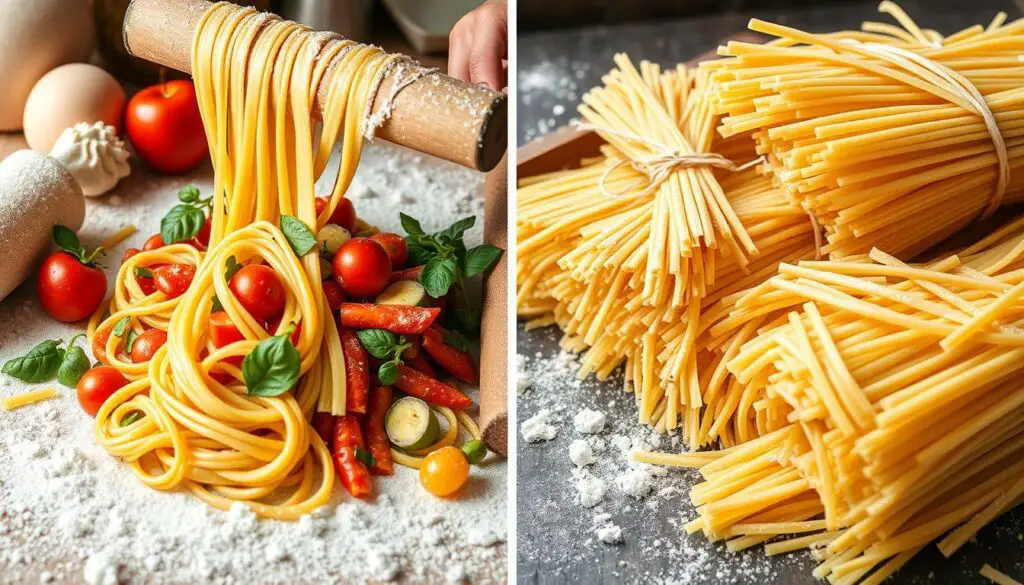
Pasta Ingredients: What Goes Into Pasta?
Pasta is a favorite in many cuisines. Knowing its ingredients is key to making the perfect dish. The main parts are flour, which affects the pasta’s texture and taste. Learning about different flours and additives can improve pasta dishes.
Types of Flour Used in Pasta Making
Flour is the base of pasta, with various types changing the final product. The main flours are:
- All-Purpose Flour: It’s versatile and has a mild taste.
- Semolina Flour: Made from durum wheat, it makes pasta firm and has a unique bite.
- Whole Wheat Flour: It has a nutty taste and is denser, adding more fiber.
- Gluten-Free Flour: There are many options for those with gluten issues, like rice and chickpea flour.
Common Additives and Their Impact on Flavor
Ingredients beyond flour can change pasta. Common ones include:
- Eggs: Used in fresh pasta, they make it rich and soft.
- Spinach and Tomato: They add color and special tastes, making pasta vibrant.
- Herbs and Spices: Basil, garlic powder, and others can make the taste even better.
Knowing about pasta ingredients, especially flours and additives, helps cooks make better dishes.
| Flour Type | Texture | Flavor |
|---|---|---|
| All-Purpose Flour | Mild | Neutral |
| Semolina Flour | Firm | Nutty |
| Whole Wheat Flour | Dense | Nutty |
| Gluten-Free Flour | Varied | Depends on type |
Pasta Cuisine Around the World
Pasta has become a favorite dish in many parts of the world, not just Italy. Each culture has its own way of making pasta, creating unique dishes loved by many. From classic Italian recipes to new twists, chefs everywhere show their creativity with pasta.
In Asia, noodle dishes offer a different take on pasta. Chinese lo mein and Japanese yakisoba use wheat and rice noodles. These dishes show how pasta can bring together different flavors from around the world.
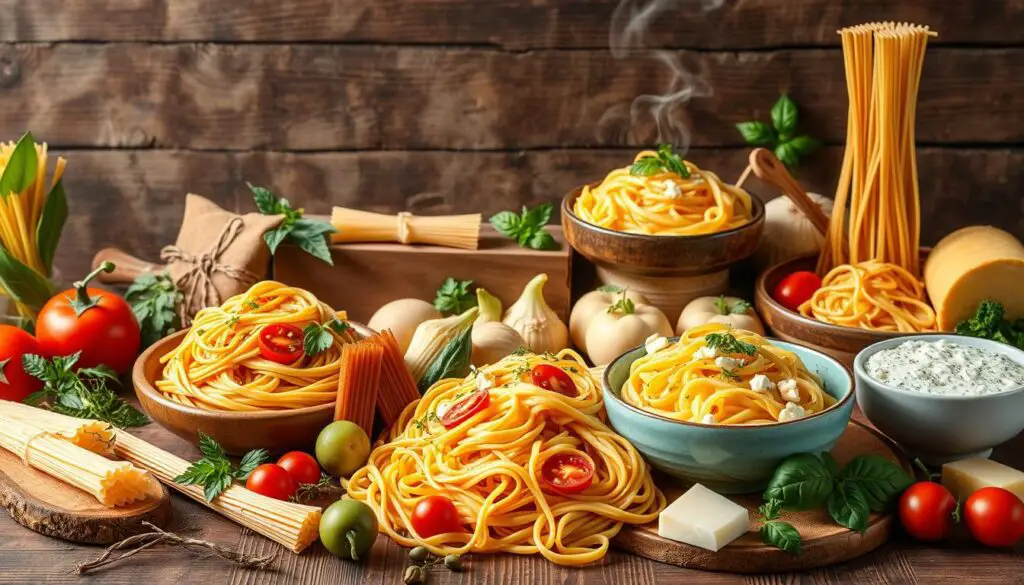
American pasta salads are another exciting twist. They mix pasta with fresh veggies and tangy dressings. These dishes are perfect for family gatherings, showing how pasta can be enjoyed in many ways.
In the Middle East, pasta dishes like “maqluba” are hearty and flavorful. They use spices and vegetables, showing how local ingredients can change traditional pasta dishes. Each of these dishes highlights how pasta can connect people from different cultures through food.
| Region | Popular Dish | Main Ingredients |
|---|---|---|
| Italy | Spaghetti Carbonara | Spaghetti, eggs, pancetta, cheese |
| Asia | Pad Thai | Rice noodles, shrimp, tofu, peanuts |
| United States | Pasta Salad | Pasta, cherry tomatoes, mozzarella, dressing |
| Middle East | Maqluba | Rice, chicken, eggplant, spices |
The love for pasta is growing, making our food world more interesting. For more on pasta, check out this essential guide. It explores different pasta types and their global versions.
The Culinary History of Pasta
Pasta holds a special place in the culinary history of many cultures. It’s thought to have started in ancient places like China and the Mediterranean. Early pasta was made from flour and water, shaped into different forms.
This ancient start helped create the wide range of pasta varieties we love today.
In Italy, pasta became a key part of the diet in the 12th century. By the Renaissance, it was a common dish in Italian homes. Chef Pellegrino Artusi wrote about making pasta and pairing it with sauces.
As pasta traveled to Europe and then the Americas, it changed. The 18th century brought tomatoes, which changed pasta dishes forever. Now, each region has its own pasta varieties, using local ingredients and traditions.
Today, chefs are making pasta in new and exciting ways. They mix old techniques with new tastes. Cookbooks and food movements show how pasta connects us to our past and culture.
| Era | Key Developments |
|---|---|
| Ancient Times | Origins in China and the Mediterranean; flour and water mixture. |
| 12th Century | Pasta becomes a staple in Italian cuisine. |
| Renaissance | Chef Pellegrino Artusi documents pasta recipes. |
| 18th Century | Tomatoes introduce new flavors in pasta dishes. |
| Modern Era | Innovation and fusion in pasta preparation. |
Conclusion
Knowing the 5 main types of pasta is key to better cooking. Each type, from long spaghetti to short penne, adds unique textures and tastes. Stuffed pasta like ravioli and tortellini adds a creative twist to your meals.
Pasta’s variety is more than just shapes and sizes. It’s a window into the culinary traditions of the world. By trying out different pasta, you can appreciate the cultural importance of pasta, especially in Italy and other places.
Exploring pasta can lead to amazing dishes. Whether you’re making simple dinners or big feasts, knowing about pasta can make your cooking better. It opens up new flavors and techniques for you to try.

